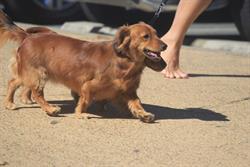Different types of animals eat different types of things
If you want to properly care for animals; it is critical that you recognise differences between species; and even breeds within a species.
 Feeding Cats
Feeding Cats
Most of the nutritional diseases seen in cats are the result of insufficient variety in their diet (A cat fed only tinned fish, will develop serious skin disorders and gastro-intestinal malfunctions). It can also result in the cat refusing other types of foods. Cats tend to be very fussy eaters, and really do need a varied diet to be established from when they are kittens in order to prevent dietary problems later. It is very important to feed your cat the best possible diet when maximum performance is required (eg. when showing, or breeding).
A cat’s specific nutritional requirements are complicated, so in order to meet all of these requirements, it is probably better to give your cat commercially prepared cat food. Never give your cat food prepared for another type of animal, such as a dog, as their dietary requirements are unique and entirely different.
Never feed your cat cooked chicken bones, they can cause stomach upsets and have the potential to perforate their intestines, causing serious infections which can result in death.
Cats have an unusually high requirement for protein -several times that of a human, on a body weight basis. A cat should also have foods that are rich in fat, in order to provide energy. It is essential that a cat gets all of the essential nutrients, in order to prevent deficiencies; for example:
acute and chronic Vitamin A deficiency can cause blindness, sterility, reduced litter size, weak or dead kittens, skeletal deformities, neurological defects, cleft palate, hairlip, emaciation, weakness of hind legs, and respiratory problems. Milk and liver are high in Vitamin A. You must ensure a cats diet is rich in all the essential nutrients!
Dry Food is good for preventing plaque and tartar build up, particularly if a lot of soft tinned food is fed. Raw chicken necks (one per week) are ideal for maintaining the gums and teeth in good order.
Feeding Dogs

Dogs are very adaptable when it comes to diet, because they have thrived in such a variety of different environments, and on a wide variety of diets. Because of this they are less likely to suffer dietary problems than many other animals. However, while a dog may survive on a less than adequate diet, this is obviously not ideal and there are some important general rules to keep your dog in the best condition. Most importantly, a dog should only be fed once a day; it should not be given treats every time it begs, or the owner eats. By sticking to top quality commercial dog food you should meet all your dogs nutritional requirements. If you purchase your pet from a breeder, ask them what food they recommend. As a rough guide, an adult dog requires daily around 15gms of food per 450gms of body weight. Around 65-70% should be protein rich food (eg. meat), while the remainder can be dry dog food or table scraps. Treats like chocolate can be toxic for dogs and rich food scraps can cause digestive problems or obesity. A diet comprised of mainly human food scraps or dry food will lead to malnutrition.
• Excessive feeding - will result in obesity and this is an increasing problem amongst pet dogs as many owner love to indulge and treat their dogs. This ‘love’ can be very dangerous as the complications from obesity include heart problems, metabolic problems, inability to exercise properly and a variety of other physical diseases such as arthritis, due to the strain on the dog’s body to carry the extra weight. Obesity will shorten a dogs lifespan.
• Inadequate feeding is not uncommon, particularly with breeders who are trying to get animals into "Show Condition". If an animal is thin but still healthy, there are two possibilities: lack of opportunity to eat, or lack of motivation to eat. However, chronic limiting of food is neglect, and it is in many areas a criminal offence, or at least punishable by a fine. A starving dog can become more aggressive, and can suffer skin conditions, metabolic problems, muscle wasting and will generally be more susceptible to illnesses.
The ideal diet for a dog is one that supplies daily all the elements needed for the dogs bodily development and functions. It should be balanced and palatable with varying textures (dry food and soft meat or tinned food). The amount of water contained in the food can influence its spoilage. As a general rule the higher the percentage of water, the poorer the stability of the food. Do not feed a dog spoilt food as it will be unpalatable and may contain bacteria or toxic products of spoilage.
Bones are rich as a source of nutrients. They also exercise the dogs jaw and keep its teeth clean. Raw bones should be supplied regularly, however avoid small chicken bones and other cooked bones as they have a tendency to shatter into small pieces, causing injuries to the mouth and palate, or digestive tract.
LEARN MORE
By studying this course you will develop a broad understanding of to the correct feeding of domestic animals (farm animals and pets) for health and productivity. Though focused mainly on domesticated animals the course is, nevertheless, still a valuable training opportunity for anyone involved in even care of wild animals.
Duration:100 hours (nominal duration)
COURSE STRUCTURE
- There are ten lessons in this unit, as follows:
- 1.Introduction to Animal Foods
- 2.Food Components: Carbohydrates, Fats
- 3.Food Components: Proteins, Minerals.
- 4.Evaluating Foods & Digestibility
- 5.Classifying Foods: Part A.
- 6.Classifying Foods: Part B.
- 7.Classifying Foods: Part C.
- 8.Calculating Rations: Part A.
- 9.Calculating Rations: Part B.
- 10. Calculating Rations: Part C.
-
- COURSE AIMS
- ·Describe the range of livestock feeds and feeding methods available for animal production, using accepted industry terminology.
- ·Explain the role of energy foods, including the sources and functions of those foods, in animal diets.
- ·Explain the function of the major nutritional groups, including proteins, vitamins, minerals and trace elements in animal diets.
- ·Explain the on-farm methods used to evaluate feeding, including selection of feeds and feed digestibility.
- ·Evaluate the dietary value of pastures, including grasses, cereals, and other edible plants, and their by-products for animal feeds.
- ·Explain the dietary value of seeds, including oil seeds, legume seeds and their by-products as food sources for animals.
- ·Evaluate the dietary value of fodder plants, including trees and shrubs and their by-products, as a food source in animal production.
- ·Determine suitable feed rations for a farm animal maintenance program.
- ·Analyse the method(s) to determine suitable feed rations in a farm animal production program.
- ·Evaluate the dietary value of protein in an animal production program.
- ·Explain the factors affecting the composition of feed rations in animal production.
-
- WHAT YOU WILL DO IN THIS COURSE
- ·Explain the importance of feed quality in livestock production.
- ·Describe the various food groups that animal foodstuffs are based upon.
- ·Define at least fifteen relevant industry terms related to livestock feed, feeding and feed processing.
- ·Explain the role of water in animal nutrition.
- ·Describe three different, commercially available, animal feeds, including the composition and appropriate uses for each.
- ·List the chemical names of at least five different carbohydrates which are of importance to animal production.
- ·Evaluate the roles of four different carbohydrates in animal metabolism.
- ·List the important sources of carbohydrates for at least four different types of farm animals.
- ·List the chemical names of at least five different fats which are important to animal production.
- ·Compare fat deposition patterns in three different animals.
- ·Explain the role of two different lipids in animal metabolism.
- ·List the important sources of fats and lipids used in livestock feeds.
- ·Explain the importance of proteins to animal production.
- ·Describe the chemical composition of naturally occurring proteins.
- ·List the sources of protein commonly used in foodstuffs for two different types of farm animal species.
- ·Explain the differences in protein requirements for different animals.
- ·List five vitamins of importance in livestock nutrition.
- ·List five minerals of importance in livestock nutrition, including their source foods, requirement levels, physiological functions, and deficiency symptoms.
- ·List five trace elements of importance in livestock nutrition, and including their source foods, requirement levels, physiological functions, and deficiency symptoms.
- ·Prepare a one page chart or table comparing the vitamin, mineral, protein and trace elements components of three different commercial animal feeds.
- ·Explain the function and source of the various nutritional components found in three different commercial livestock nutrient supplements.
- ·Describe the components of a specified animal feed.
- ·Distinguish between the 'protein value' and 'energy value' of two specified animal feeds.
- ·Explain the concept of 'digestibility' as it relates to animal feed.
- ·Describe the techniques used to calculate digestibility of animal feeds.
- ·Perform a calculation of digestibility for a specified feed.
- ·Describe two standard methods used to assess animal feeds.
- ·Compare five different feeds, in terms of composition, relative digestibility, palatability.
- ·List at least five cereal and cereal by-product feeds used in animal production.
- ·Describe the food value characteristics of five cereals and cereal by-product feeds used in animal production.
- ·List at least five grasses and forage crops used as farm animal feeds.
- ·Describe the dietary value of five forage crops, including grasses, used in animal production.
- ·List at least five harvested feed products, including hay, roughage and silage used as feeds in animal production.
- ·Explain the dietary value characteristics of five harvested feed products including hays, roughage and silage used in animal production.
- ·Explain the dietary value of a growing pasture, on a farm visited and studied by you.
- ·Compare the nutritional value to farm animals, of ten different pasture foodstuffs, including cereals, grasses, hay and their by-products.
- ·List four oil seeds (or their by-products) used as feeds in animal production.
- ·Explain the use of oil seeds (or their by-products) as animal feeds.
- ·List three legume seeds used as feeds in animal production.
- ·Evaluate the dietary value of three different legume seeds, as animal feeds.
- ·Collect small samples of three oil seeds and three legume seeds.
- ·Compare the characteristics of two different oil seed species, with two different legume seed species. List five fodder plants (or their by-products) used as feed in animal production.
- ·Provide recommendations on how three different fodder plant species may be used as an animal feed source on a specified farm.
- ·Compare the nutritional value of three different fodder plant species.
- ·Explain the objective of maintenance rationing in two different farm situations observed by you.
- ·Explain the differences in feed rations given to maintain the same type of animal on two separate farms.
- ·Describe the nutritional requirements of two different specified types of livestock.
- ·Calculate a 'maintenance feed ration' for a specified farm animal.
- ·Develop a maintenance feeding program, for a group of animals, such as a herd of cattle or flock of sheep.
-
- Click here to enrol in Animal Feed and Nutrition
